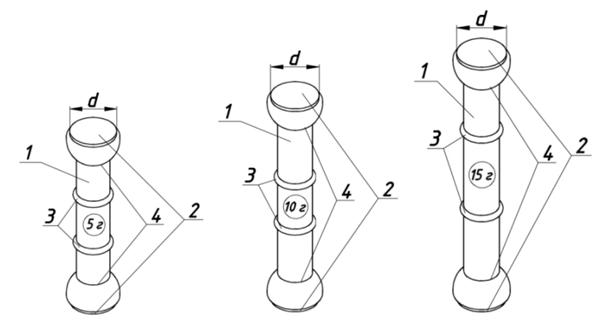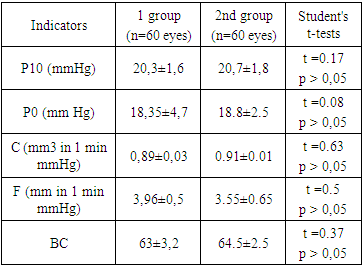-
Paper Information
- Next Paper
- Previous Paper
- Paper Submission
-
Journal Information
- About This Journal
- Editorial Board
- Current Issue
- Archive
- Author Guidelines
- Contact Us
American Journal of Medicine and Medical Sciences
p-ISSN: 2165-901X e-ISSN: 2165-9036
2024; 14(4): 867-868
doi:10.5923/j.ajmms.20241404.14
Received: Mar. 3, 2024; Accepted: Mar. 29, 2024; Published: Apr. 2, 2024

New Ways to Measure Intraocular Pressure in Children with Microphthalmia and Blepharophimosis
Khamraeva Lola Salimovna, Narzullaeva Dildora Uktamovna, Bobokha Lyubava Yurevna, Makhmudova Dilorom Teshaevna
Department of Ophthalmology, Pediatric Ophthalmology Tashkent Pediatric Medical Institute, Tashkent, Uzbekistan
Correspondence to: Narzullaeva Dildora Uktamovna, Department of Ophthalmology, Pediatric Ophthalmology Tashkent Pediatric Medical Institute, Tashkent, Uzbekistan.
| Email: |  |
Copyright © 2024 The Author(s). Published by Scientific & Academic Publishing.
This work is licensed under the Creative Commons Attribution International License (CC BY).
http://creativecommons.org/licenses/by/4.0/

Childhood glaucoma is a chronic vision-threatening condition that may significantly impact an individual’s psychosocial well-being. The prognosis of glaucoma largely depends on early and accurate diagnosis and successful treatment, including control of increased. The purpose is to determine the effectiveness of modified tonometers (Maklakova) NGm2-OF TP in performing tonometry and tonography in infants and children with microphthalmos and blepharophimosis. We have proposed modified models of Maklakoff tonometers weighing 5, 10, and 15 g, made of silver, the weights on both sides have contact plates, which are made of medical plastic and have a diameter of the applanation area d=8 mm. Methods: Tonometry and tonography using the simplified method of Nesterov A.P. were carried out in 30 (60 eyes) children aged from birth (0) to 16 years. Results: Our recommended design of weights showed results that do not differ from those obtained using standard Maklakov tonometers. At the same time, modified weights provide the opportunity to determine tonometric IOP and eye hydrodynamics in newborns and patients with microphthalmia and/or blepharophimosis, which greatly facilitates the work of pediatric ophthalmologists and reduces examination time.
Keywords: Childhood glaucoma, Intraocular pressure, Maklakoff tonometers
Cite this paper: Khamraeva Lola Salimovna, Narzullaeva Dildora Uktamovna, Bobokha Lyubava Yurevna, Makhmudova Dilorom Teshaevna, New Ways to Measure Intraocular Pressure in Children with Microphthalmia and Blepharophimosis, American Journal of Medicine and Medical Sciences, Vol. 14 No. 4, 2024, pp. 867-868. doi: 10.5923/j.ajmms.20241404.14.
1. Introduction
- The prognosis of glaucoma largely depends on early and accurate diagnosis and successful treatment, including control of increased (IOP). At the same time, it is important to carry out tonometry (study of tonometric pressure P10) and tonography (determination of true IOP - P0, production of intraocular fluid - F, outflow of intraocular fluid - C, Becker coefficient - BС). The first reasonably accurate instrument was the Maklakoff applanation tonometer [1]. Particularly difficult is the technique of measuring IOP with existing Maklakoff tonometers NGm2-"OFT-P" in infants and children with microphthalmia (congenital reduction of the eyeball and cornea, when the horizontal diameter of the cornea is less than 10 mm, and the vertical diameter is less than 9 mm) and/or blepharophimosis (small size of the palpebral fissure, when at maximum opening: the horizontal size of the palpebral fissure is less than 20 mm, and the vertical size is less than 10 mm), since these tonometers, having an applanation plate diameter of 10 mm, allow their use only in adults and children with the dimensions of the cornea and palpebral fissure the same as in adult patients [2]. The well-known Goldmann tonometers and Filatov-Kalf elastotonometers NGm5-“0FT-P” also cannot be used for tonometry and tonography in newborns and in patients with reduced biometric parameters of the eyes [3].Existing IGD devices also do not allow to determine tonometric and tonographic indicators of the eye in newborns. The use of different methods in children for measuring IOP in newborns leads to a huge range of values from relative hypotension (Icare Tiolat tonometer) to hypertension (tonometer by Maklakoff) [4].The purpose is to determine the effectiveness of modified tonometers (Maklakova) NGm2-"OFT-P" in performing tonometry and tonography in infants and children with microphthalmos and blepharophimosis.
2. Material and Methods
- To achieve this goal, we have proposed modified models of Maklakoff tonometers weighing 5, 10, and 15 g (Fig. 1), made of silver, made in the form of hollow cylindrical columns (1), ending through a neck (4) with smooth contact plates (2). Two marks (3) are applied to the cylindrical posts of the weights, corresponding to 1/3 of their height. The weights on both sides have contact plates (2), which are made of medical plastic and have a diameter of the applanation area d=8 mm.
 | Figure 1. Modified models tonometers by Maklacoff weighing 5 g (A), 10g (B) and 15g (C) (main view, isometric projection) |
3. Result and Discussion
- Tonometry and tonography using the simplified method of Nesterov A.P. were carried out in 30 (60 eyes) children aged from birth (0) to 16 years. Of these, 17 (34 eyes) were infants, 14 (28 eyes) had anterior microphthalmia 2, 3 degrees, and 9 (18 eyes) had blepharophimosis. The first stage was measurements with modified tonometers (group 1), then after 10-15 minutes - with standard Maklakov tonometers (group 2). The measurement results are shown in Table 1.
|
4. Conclusions
- Thus, our recommended design of weights showed results that do not differ from those obtained using standard Maklakov tonometers. At the same time, modified weights provide the opportunity to determine tonometric IOP and eye hydrodynamics in newborns and patients with microphthalmia and/or blepharophimosis, which greatly facilitates the work of pediatric ophthalmologists and reduces examination time.
 Abstract
Abstract Reference
Reference Full-Text PDF
Full-Text PDF Full-text HTML
Full-text HTML